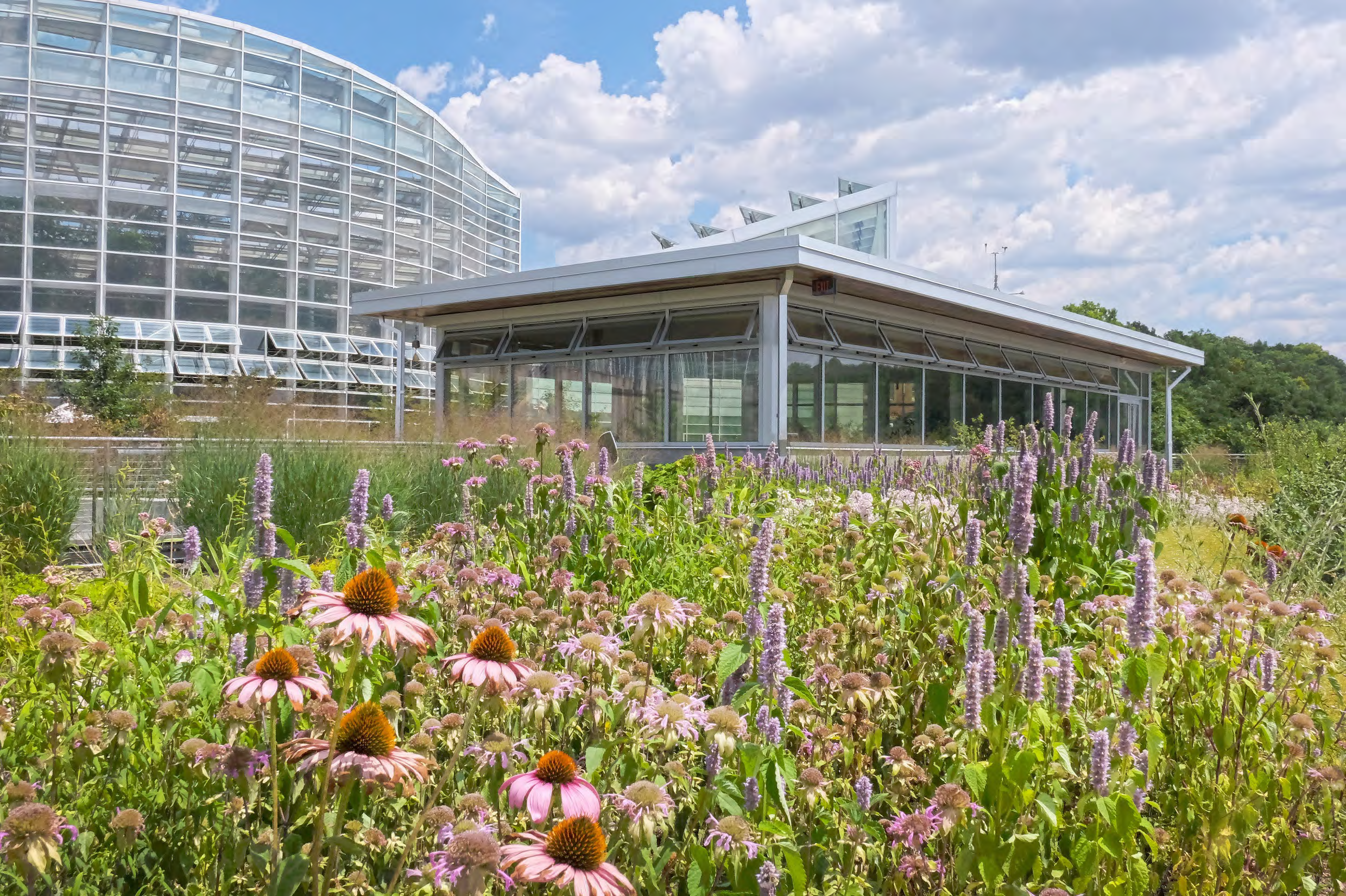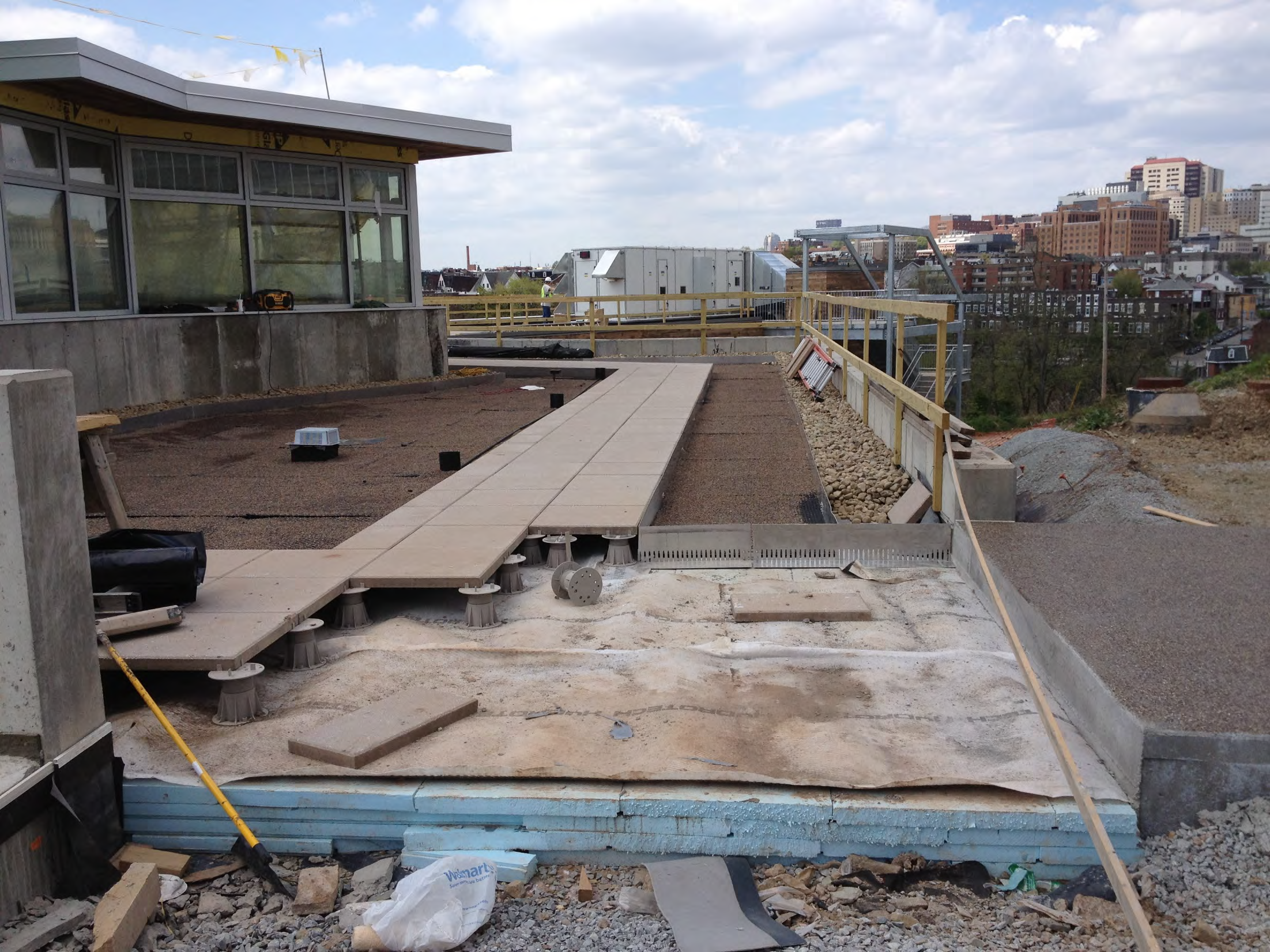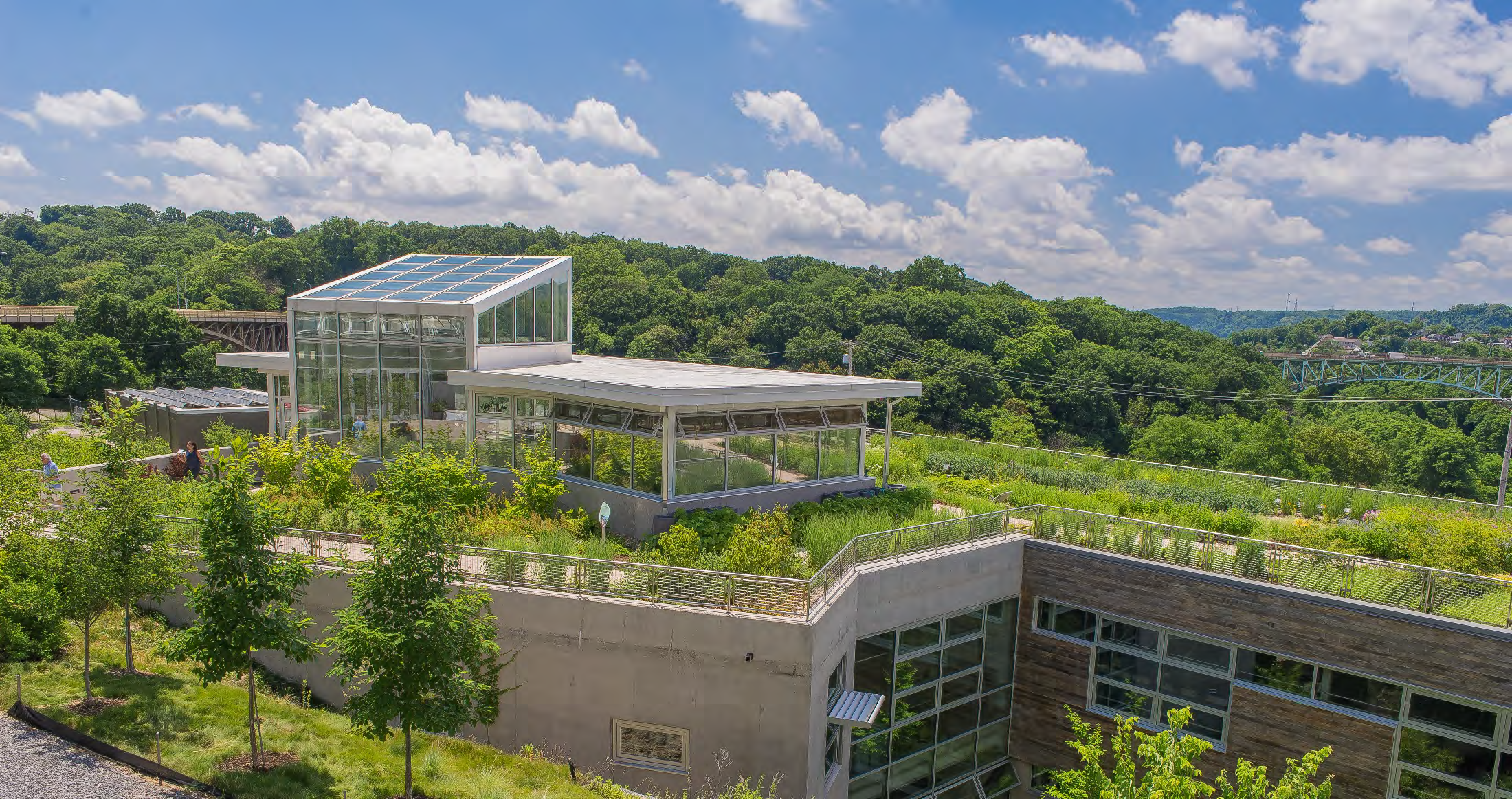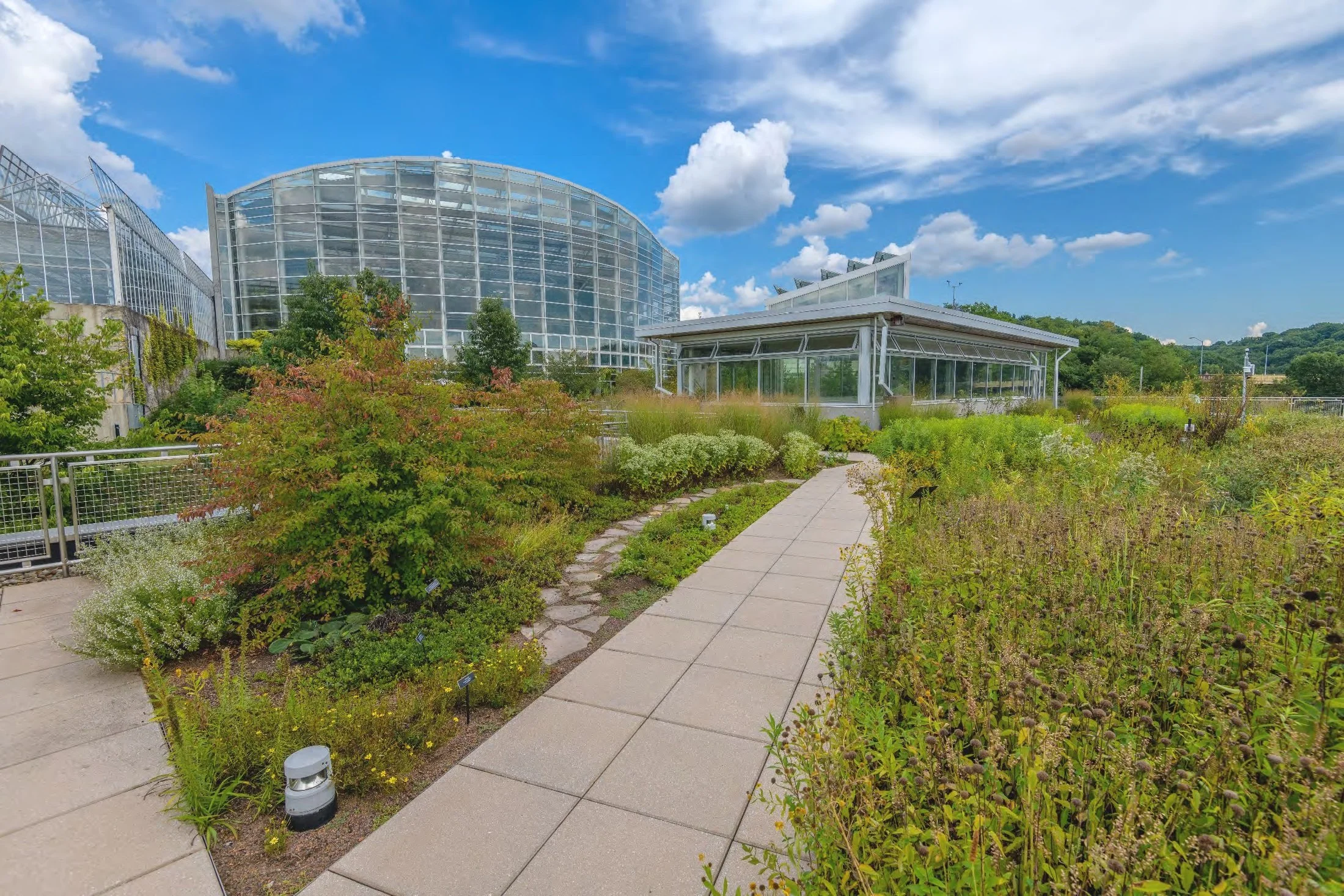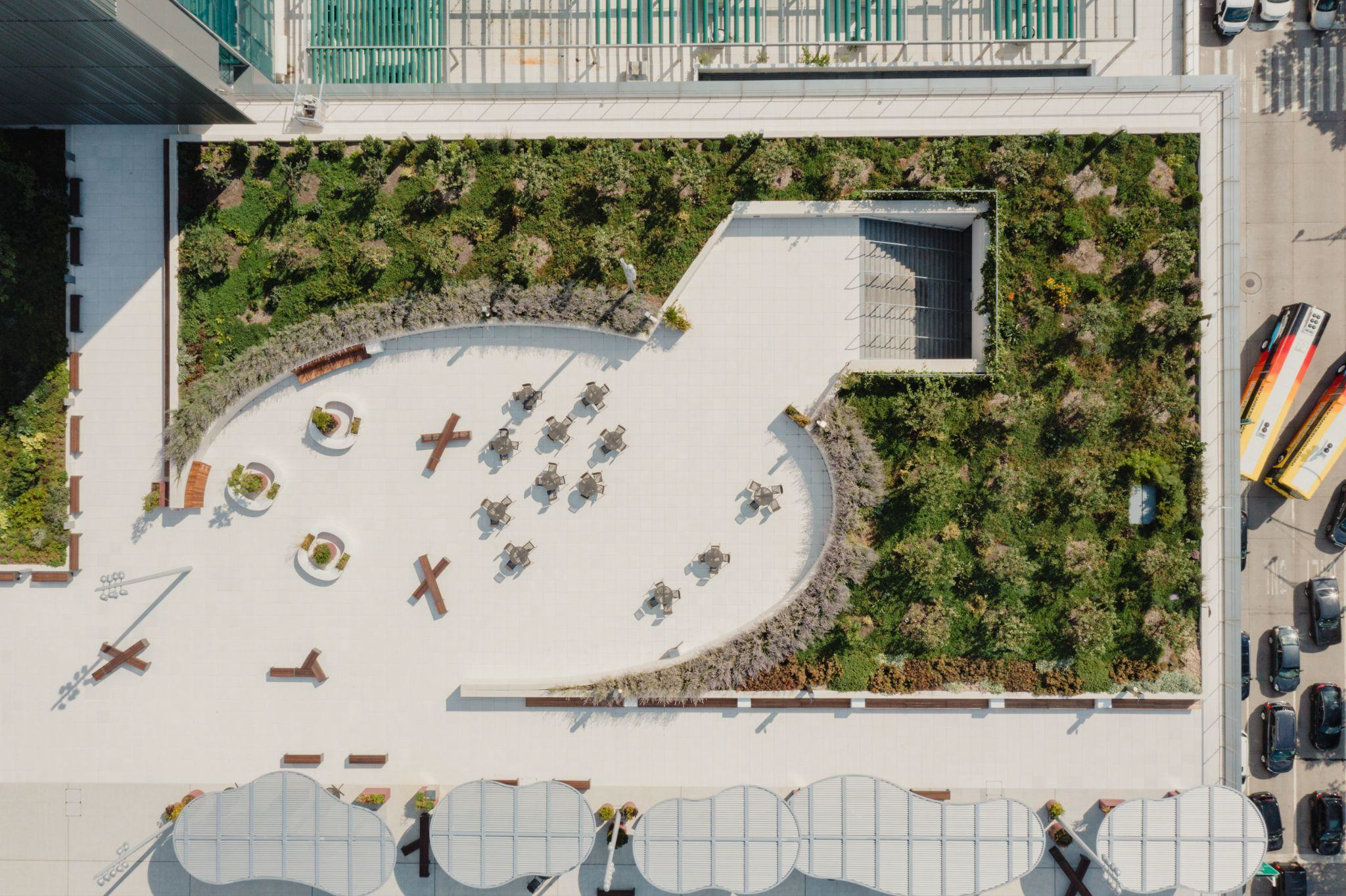The Center for Sustainable Landscapes – An Ecological Showpiece in Pittsburgh
Advertisement
Phipps Conservatory and the Center for Sustainable Landscapes
The Phipps Conservatory and Botanical Gardens is located in the Schenley Park area of Pittsburgh, Pennsylvania. Founded in 1893, the gardens have sought to inspire and educate the public on the beauty and importance of plants, and typically welcome more than half a million visitors and 35,000 education program participants annually. The gardens cover 15 acres and include a 14-room glasshouse, 23 distinct gardens, and as of 2012, The Center for Sustainable Landscapes. Since its opening, the Center has become the first and only building project to meet five of the highest green certifications: the Living Building Challenge, LEED Platinum, WELL Building Platinum, SITES Platinum, and BREEAM Outstanding In-Use. Widely regarded to be one of, if not the, most sustainable buildings in the world, The Center for Sustainable Landscapes generates all of its own energy; treats and reuses all water captured on site; and enhances and reinforces local ecosystems and biodiversity networks. In 2020, the Center won a Jeffrey L. Bruce Award of Excellence, an awards program that celebrates excellence in green roof and wall projects by Green Roofs for Healthy Cities.
A variety of plants growing on the green roof. See the full plant list at the bottom of this article. Photo: Phipps Conservatory and Botanical Gardens
Collaborative Creation and Holistic Planning
The Center for Sustainable Landscapes was designed to be an education and demonstration site to explicate the efficacy of sustainability in the commercial and residential arenas, and the beauty of living in harmony with the natural world. Phipps’ mission is to advance sustainability and promote human and environmental well-being through action and research. In support of this mission, the project objective was to help transform the way people relate the built and natural environments. To that end, community and project partners were welcomed early to the project to contribute energy, systems, computational fluid dynamics modeling, restoration ecology, green building, innovative technology, life cycle assessment and other consulting services. Partnerships were sought with the goal of pursuing environmental research, education and outreach through the involvement of scientists, research fellows and department members so that collaborative research opportunities could create a ”critical mass” and enhance the ability to obtain grants for research of greater scope and importance. This enabled the team to carefully consider how prospective project elements might relate to one another for maximum eco-harmony and efficiency, refining concepts and developing designs to support the project’s holistic success while affirming the values and needs of the region’s residents and the environment.
Advertisement
Enhancing Ecosystems and Incorporating Context
The place-based identity of the project comes through in its project site, where an area once classified as brownfield now hosts 1.5 acres of green space with a variety of plant communities inspired by local ecology. From a water management system based on the green roof, natural lagoons and constructed wetlands, to a building skin reclaimed from dilapidated area barns, environmental features lend the building a natural, organic character while helping to achieve its net-zero energy and water goals.
Early in the planning stage for the project, an integrated design team conducted a site assessment. The entire site was found to be disrupted and to contain severely degraded and disturbed soils that primarily consisted of fill material and a documented brownfield. For more than a decade, the site had been used as a fill site by the city’s Department of Public Works. Prior to construction, the site’s south-facing slope’s high pH soils restricted vegetative growth to plants found in early stages of succession, according to the site assessment. The majority of the site contained no vegetation at all.
The goal of the project was to restore a degraded brownfield into a beautiful, useful facility that is healthy for people and the ecosystem and to highlight the important connections between the built and natural environments, and being sensitive to that guided the entire project from concept to operations.
The construction of the green roof. All the layers under the actual plants can be seen here. Photo: Phipps Conservatory and Botanical Gardens
Plants selected for the pollinator-friendly certified landscape are native to the ecoregion and many of them occur in one or more of the plant communities that inhabit the region. As the landscape matures, succession is gradually taking place. Some species will become less prevalent as others take over. As conditions change, new species may be added to fill these new microhabitats, mimicking the dynamic and changing balance seen in nature. In recognition of the role of humans in the ecosystem, plants were selected based not just on nativity but historical human use, whether for medicine, food or crafts.
To manage invasive plants, non-native species are removed by mechanical means. New weeds that have yet to establish are hand pulled, while established stands are cut repeatedly through the growing season. Invasives are prevented through increasing competition and minimizing bare soil. Similarly, soil disturbances from wildlife, erosion and human activities are limited, which helps encourage thick, vigorous growth of natives. Seeds are collected on site in the fall and hand-broadcast.
The site now is home to more than 100 species of native plants, including 50 on the green roof alone. These species increase the plant biodiversity, as well as native wildlife and pollinators. Deer, herons, foxes, monarch butterflies, yellow-bellied sapsuckers, hummingbirds, bullfrogs and other native species have been seen on the site. The green roof has demonstrated an increase in biologic activity, including insects, pollinators and even deer.
Advertisement
Maintaining The New Wilds
The goal of the project maintenance plan is to enhance ecological integrity, improve natural diversity, and provide food, water and shelter for wildlife, all while remaining aesthetically pleasing and congruent with horticultural best practices. Only rainwater was used to irrigate during establishment, which was applied slowly to minimize runoff. Watering is typically not required, except during extreme heat or drought, at which time captured rainwater is used. As with the landscape, perennials are cut back in the early spring. Dead or diseased materials are pruned while all other pruning takes place in late winter. Weeding is done as necessary using only mechanical methods.
The roof blends in with the surrounding nature. Photo: Phipps Conservatory and Botanical Gardens
Bare soil leads to excessive heating and drying and provides a place for weeds to grow. To prevent weeds and strengthen growth of desirable plants, horticulturists work to minimize bare soil through watering, fertilization, additional planting and propagation. This is done within the limits of the original design. Pests are controlled through integrated pest management. The established landscape tolerates low to moderate pest levels. This balanced ecosystem, in which pests and beneficial organisms coexist within a natural equilibrium, requires little attention beyond regular maintenance. This hierarchical approach promotes monitoring, preventive cultural practices, physical controls, biological controls and, if necessary, responsible pesticide use.
The population and health of the plants onsite are recorded following each growing season in the Plant Inventory. The Inventory tracks species that have become extirpated from the site, as well as additional species that were purposefully introduced, or native volunteer species that have developed. Soil tests are conducted yearly to monitor changes in soil chemistry as the engineered growing medium matures.
Advertisement
A Vision Realized
The Phipps Conservatory and Botanical Gardens, along with the Center for Sustainable Landscapes have become a showpiece of sustainability, ecological rehabilitation, and ecosystem functionality. The care and consideration taken in the design, planning, and execution process have established a thriving and lush redevelopment of a formerly stripped bare site and reflect the multi-variable nature of natural ecosystems and biodiversity forces. Incorporating a variety of expertise, and giving careful consideration to the utilization of natural infrastructure and natural analogs have delivered a multitude of high functioning performance benefits, driving sustainability excellence that is truly unique.
Plants growing naturally along the sidewalk, some leaning in. Photo: Phipps Conservatory and Botanical Gardens
Advertisement
Resources
To read more about award winning green roof and wall projects visit here.
Green Roof Plant List
BOTANICAL NAME - COMMON NAME
Perennials
Echinacea purpurea 'Ruby Star' - Purple Coneflower
Echinacea purpurea 'White Swan' - Purple Coneflower
Fragaria virginiana - Wild Strawberry
Helianthus giganteus - Tall Sunflower
Heuchera 'Dale's Strain' - Coral Bells
Iris versicolor - Blue Flag Iris
Liatris spicata - Dense Blazing Star
Lobelia cardinalis - Cardinal Flower
Matteuccia struthiopteris - Ostrich Fern
Mertensia virginiana -Virginia Bluebells
Monarda didyma 'Jacob Cline' - Beebalm
Monarda fist. 'Claire Grace' - Beebalm
Monarda punctata - Spotted Beebalm
Pycnanthemum muticum - Blunt Mountainmint
Opuntia humifusa - Prickley Pear Cactus
Panicum virgatum ‘Heavy Metal’ - Heavy Metal Switchgrass
Podophyllum peltatum - Mayapple
Salvia lyrata 'Purple Knockout' - Lyre-leaf Sage
Scutellaria incana - Hoary Skullcap
Sedum ternatum 'Larinem Park' - Stonecrop
Sisyrinchium ang. 'Lucerne' - Blue-Eyed Grass
Solidago caesia - Wreath Goldenrod
Tradescantia 'Bilberry Ice' - Spiderwort
Viola blanda - Sweet White Violet
Viola sororia - Common Blue Violet
Shrubs
Arctostaphylos usa-urvi - Bearberry
Aronia arbutifolia - Chokeberry
Corylus americana - American Hazelnut
Hamamelis virginiana - Witchazel
Myrica pensylvanica - Bayberry
Physocarpus opulifolius 'Summer Wine' - Summer Wine Ninebark
Rhus aromatica 'Gro-Low’ - Gro-Low Fragrant Sumac
Rubus odoratus - Flowering Raspberry
Viburnum prunifolium - Blackhaw Viburnum
Viburnum lentago - Nannyberry Viburnum
Perennials
Agastache foeniculum - Anise Hyssop
Allium cernuum - Nodding Onion
Amsonia tabernaemontana var. salicifolia Arkansas - Blue Star Flower
Asclepias incarnata - Red Milkweed
Asclepias syriaca - Common Milkweed
Aster cordifolius - Blue Wood Aster
Aster novae-angliae 'Vibrant Dome' - New England Aster
Baptisia 'Twilite' Prairieblues TM - Twilite Prairieblues False Indigo
Calamintha nepeta 'White Cloud' - White Cloud Calaminth
Calamintha nepeta ssp. nepeta - Calaminth
Chrysogonum virg. var. australe - Green and Gold
Cypripedium parviflorum var. pubescens - Greater Yellow Lady's Slipper
Cypripedium reginae - Showy Lady's Slipper
Echinacea paradoxa - Yellow Coneflower

